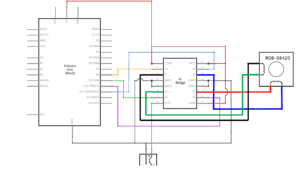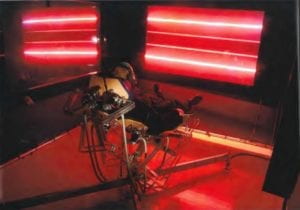Circuit: Drawing Machine

Components:
1 * 42STH33-0404AC stepper motor
1 * SN754410NE ic chip
1 * power jack
1 * 12 VDC power supply
1 * Arduino kit and its contents
2 * Laser-cut short arms
2 * Laser-cut long arms
1* Laser-cut motor holder
2 * 3D printed motor coupling
5 * Paper Fasteners
1 * Pen that fits the laser-cut mechanisms
Paper
Videos:
Note: Video 1 is for the demonstration of the stepper. Video 2 shows how to use the capacitor to control the stepper. Video 3 is a demonstration of the drawing machine.
Process:
This week’s circuit is the most complicated one I have ever built so far, which you can tell from the shot of the breadboard in the first video. I made a mistake at the very beginning that I did not make use of the two rows of ports with positive and negative signs. All of the jumper cables crowd around the ic chip and if there is any connection problem, it would be very difficult for me to find it out. What is good is that I did not encounter any problem in the first stage and the stepper moved just the same as instruction. I also noticed an interesting phenomenon that my Arduino works well without the 12V power supply. It seems that the USB port on my laptop can supply the stepper with enough electricity.
In the second stage when I was about to install the capacitor, I felt a little bit confused because I did not see much difference whether or not to install the capacitor. My partner Guangbo also had this problem and Professor Cossovich told us that it is because of the poor contact between the breadboard and the capacitor. By using the analogRead example first, we would be able to make sure that the capacitor is transmitting the correct number back to the Arduino and the problem was solved.
At last, when we were going to make the drawing machine, we find it very hard to keep the two 3D printed motor coupling on the same surface. Also, the two steppers could not cooperate very well. The one controlled by Guangbo often moves too fast and could not answer to the adjustment of capacitor timely. We think this problem may be solved if we reduce the speed of the stepper by making some modifications to the code.
Question 1:
The machine I want to make is one that involves multiple sources of input to process and produce individualized output. It does not only collect physical inputs such as the rotation of capacitors or pressing buttons but can also conceive the environment it is at or other conditions that the user did not intend to let the machine know. I do not favor choosing swift actuators because I would like to make the users see the entire process of how their input could trigger the output clearly. To my understanding, this process itself is a kind of art – the art of digital manipulation. What is more, the output should be presented in a form that maximizes its aesthetic value. I hope to reach a realm that the users do not view my machine as a simple combination of actuators but something that can communicate or even maintain emotional ties with them.
Question 2:
The art installation I would like to choose is Gastarbyter made by London Fieldworks (Bruce Gilchrist and Jo Joelson) and Dugal McKinnon.

This project, finished around the year of 2000, wants to stress the importance of listening and touching rather than seeing. The designer uses cylinders to simulate the feeling of physical vibration but the displays are reduced to neon lights. I think the concept of immersing oneself with multiple dimensions of senses is really interesting and this is what scientists of physical computing have been pursuing. With the invention of faster computers, people would like to create scenarios that most resemble the real world. However, after 20 years of evolution, the development path of the equipment we use to create ‘multi-sensual experience’ did not quite follow what the Gastarbyter did. We can see in the latest VR technologies, what the developers focus on is still the sight and those gadgets which connect our body to the computer are simplified as universal gamepads. In other words, although you may be playing dramatically different games and seeing different scenes in your headset. The reaction your body received from the joysticks may just be similar to each other. Now, 20 years have passed since the presentation of Gastarbyter. We have more advanced actuators instead of cylinders and neon lights but we still need to go back and reflect on our understanding of human perception based on the prototypes of immersed experience such as Gastarbyter.
As for Gastarbyter‘s comparison with the drawing machine we made on Friday, I think they are very different. From my perspective, the main purpose of the drawing machine is to expand human beings’ physical ability to do certain tasks like drawing. However, Gastarbyter is used to expand human beings’ recognition ability through feelings of various dimensions. They all originated from the idea of physical computing but arrive at very different results.